Dental caries is a multifactorial, sugar-dependent disease driven by the dynamic interactions of cariogenic and commensal microbes within dental plaque (biofilms) formed on tooth surfaces. Although dental biofilms are complex consisting of diverse microbial communities, Streptococcus mutans (S. mutans) has been considered to be the major pathogen in the initiation and development of dental caries, especially in the early childhood caries (ECC).
Glucosyltransferases (Gtfs) play critical roles in the etiology and pathogenesis of S. mutans– mediated dental caries including early childhood caries. Gtfs enhance the biofilm formation. And it promotes colonization of cariogenic bacteria by generating biofilm extracellular polysaccharides (EPSs). EPSs is the key virulence property in the cariogenic process.

G43 is a potent, selective glucosyltransferase inhibitor.
G43 is a glucosyltransferase inhibitor with the Kd of 3.7μM and 46.9 nM for GtfB and GtfC, respectively. It has antibacterial to S. mutans in vitro and in vivo, and can be used for dental caries study.
In a research, first, G43 (16 h, 12.5 μM) inhibits more than 85% of S. mutans biofilm. Second, G43 (25 μM, 24 h) reduces the glucan production by the Gtfs, and consistently inhibits the activity of both GtfB and GtfC with 80% inhibition of both enzymes. Third, G43 (up to 25 μM, 24 h) shows no significant difference on expression of gtfs (gtfB, gtfC and gtfD) in UA159 cells. Furthermore, G43 (50 μM, 24-48 h) reduces the biofilm formation by decreasing the production of Water-insoluble extracellular polysaccharide in wild-type S. mutans. Finally, G43 (100 µM twice daily for 4 weeks, topically administration) reduces S. mutans virulence in vivo.
Reference:
[1] Zhang Q, et al. Sci Rep. 2017 Jul 20;7(1):5974.
[2] Zhang Q, et al. Int J Oral Sci. 2021 Sep 30;13(1):30.